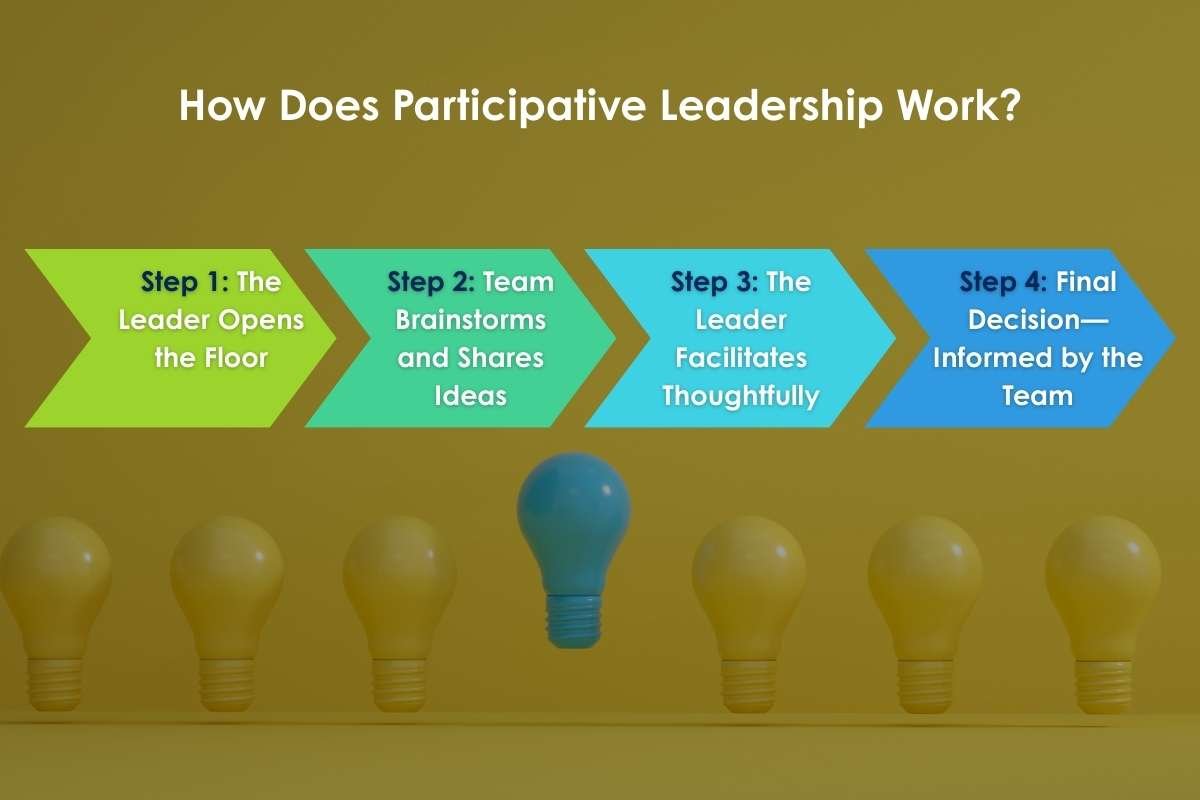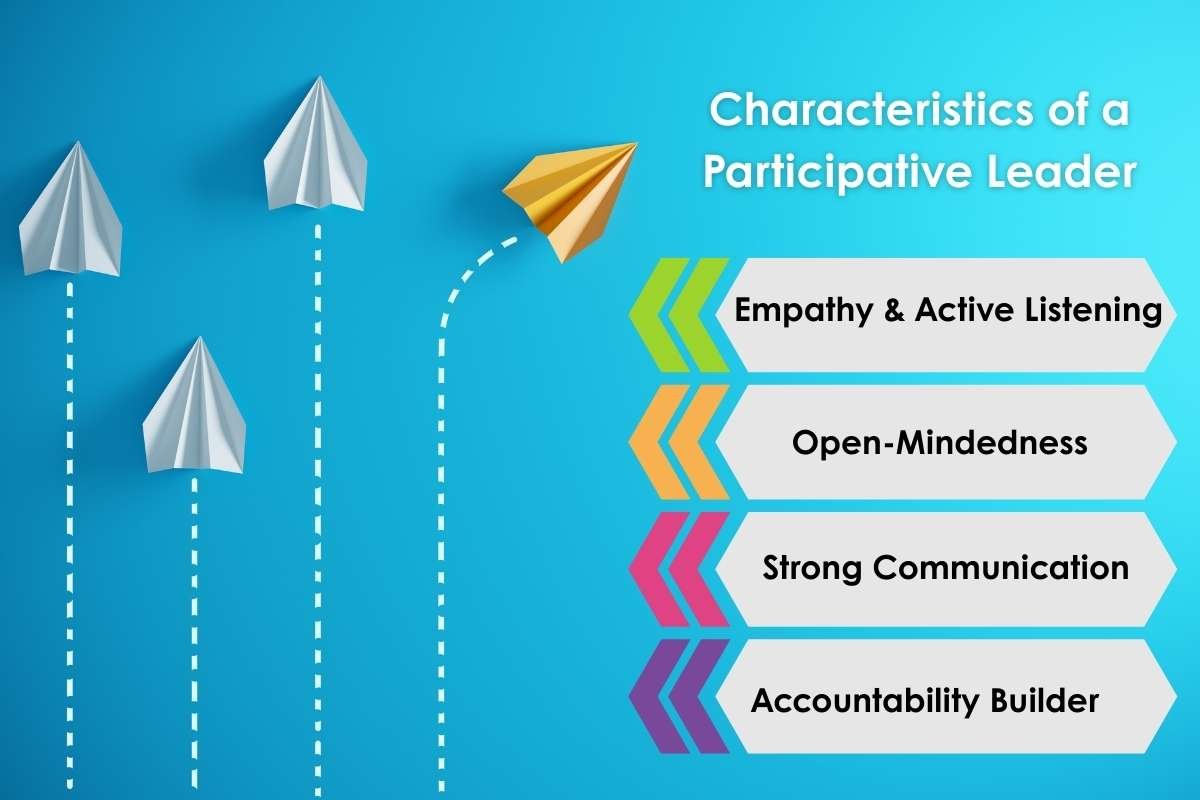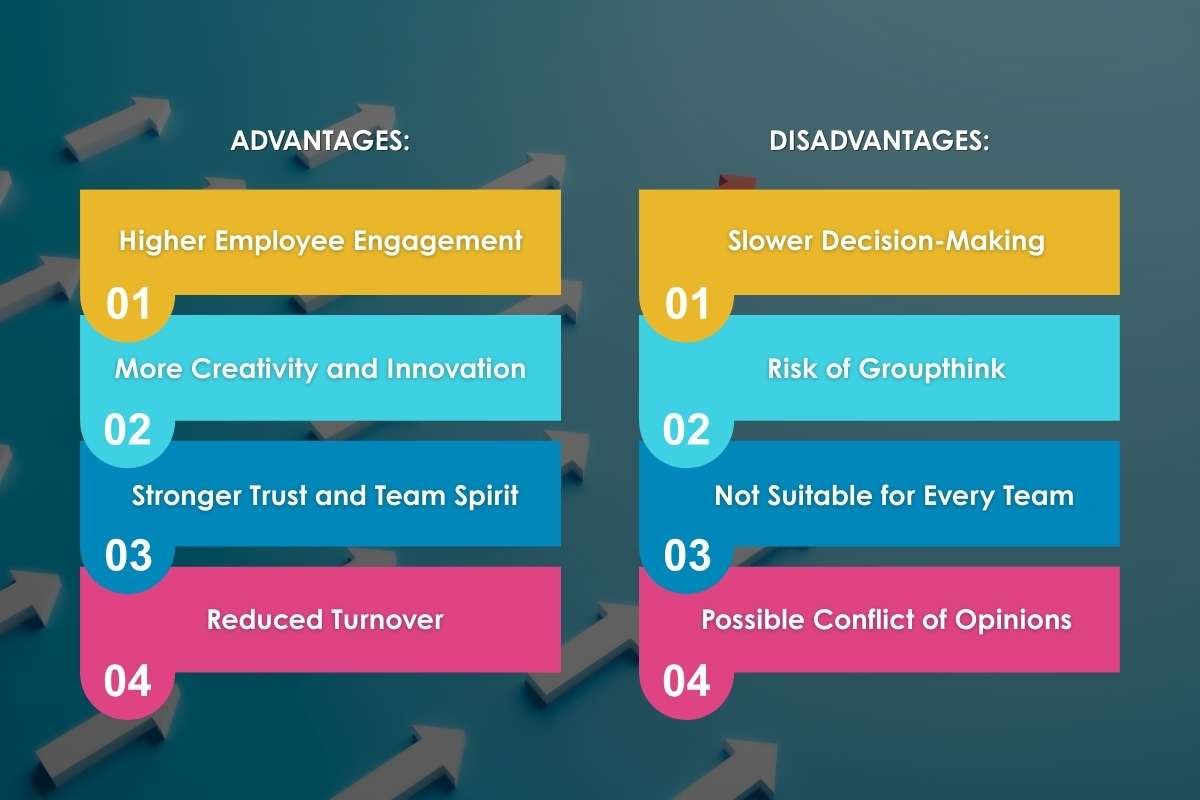Why do some leaders inspire innovation while others struggle to get results? The answer often lies in how they make decisions. Instead of calling all the shots alone, Participative Leadership puts the spotlight on teamwork, inviting ideas, sharing responsibility, and making people feel heard.
The impact is huge. Gallup research shows that engaged employees can boost productivity by 17% and profitability by 21%. And nothing drives engagement like a leader who actually listens. When people are part of the decision-making process, they don’t just follow orders; they own the outcome.
Look at Microsoft under Satya Nadella or Toyota under Jim Lentz; both built cultures where collaboration and shared decisions fueled growth. That’s the power of participative leadership in action.
As workplaces shift toward hybrid models and fast-paced changes, this style isn’t just a trend; it’s becoming a must-have for leaders who want to build trust, spark creativity, and keep their teams truly invested.
What Is Participative Leadership?
At its core, it is about shifting from “command and control” to “listen and collaborate.” Instead of leaders making every decision behind closed doors, this style encourages team members to contribute ideas, share opinions, and take part in shaping outcomes.
It’s often called democratic leadership, but there’s a key difference: in participative leadership, the leader still has the final say, while team input plays a central role in reaching that decision. Think of it like a roundtable discussion, everyone has a voice, but the leader ensures focus and direction.
Here’s Why This Style Matters:
- A 2025 study highlights that leadership boosts employees’ radical creativity, and people feel more empowered and secure to take risks and propose bold ideas.
- Moreover, research firmly links this leadership with stronger employee self-efficacy (confidence in one’s abilities) and psychological security, which in turn fuel both innovation and performance.
Participative leaders don’t just hand out tasks; they spark confidence, creativity, and collaborative ownership. And that’s what makes teams not just work hard but work smarter together.
How Does Participative Leadership Work?
Participative leadership isn’t just about letting people talk; it’s about creating a structured way for teams to share ideas, weigh options, and move forward together. The process works step by step, making sure every voice matters while still keeping decision-making efficient.

Step 1: The Leader Opens the Floor
The leader begins by inviting team contributions, whether through brainstorming sessions, surveys, or open discussions. A supportive organizational culture powered by this type of leadership has been directly linked to higher job satisfaction and organizational commitment. In a 2024 study of diverse workplaces, this connection significantly improved employee productivity and loyalty.
Step 2: Team Brainstorms and Shares Ideas
Once the floor is open, team members bounce around ideas, challenge assumptions, and explore options together. In higher education institutions, leadership was shown to boost innovation, organizational commitment, and overall performance, all with strong statistical significance (innovation: path coefficient = 0.359, commitment: 0.363, performance: 0.158; p < 0.001).
Step 3: The Leader Facilitates Thoughtfully
Here’s where a leader becomes a guide, not a judge, encouraging quieter voices, steering the discussion, and ensuring all viewpoints are considered. A 2025 psychology study found that leadership dramatically enhances radical creativity by fostering psychological safety and ………
Step 4: Final Decision—Informed by the Team
Although the leader often delivers the final call, it reflects team input. This isn’t just theory in practice; leadership was linked to SMEs’ survival post-COVID: employees’ innovative behaviors, when amplified by such leadership, significantly increased these businesses’ endurance during the crisis.
For Example, The Product Design Firm
Imagine a product design manager preparing for a new launch. Instead of deciding the marketing strategy alone, she brings together designers, sales staff, and customer service reps. Each team member shares insights from customer feedback to design constraints. The leader moderates the discussion, ensuring all voices are heard. The final strategy reflects everyone’s input, resulting in a more innovative and market-ready plan.
This collaborative approach isn’t just feel-good leadership; it’s effective. Harvard research confirms that organizations practicing shared decision-making foster stronger performance outcomes, higher engagement, and more sustainable innovation.
Also Read:
- Types of Leadership Styles: A Comprehensive Guide
- Find Your Tribe: 25 Best Leadership Communities Redefining Success in 2025
Categories of Participative Leadership
1. Collective Decision-Making
| Best For | Flat organizations, nonprofits |
| Challenges | Slow process, risk of conflicts |
Everyone has an equal voice; the team collaborates to decide together.
- Encourages open dialogue where no opinion is overlooked.
- Builds strong trust and transparency within the group.
- Works best in organizations with flatter hierarchies.
2. Consensus Decision-Making
| Best For | High-stakes, sensitive projects |
| Challenges | Decision paralysis, time-consuming |
The decision only moves forward if everyone agrees. It ensures strong commitment but may take longer.
- Promotes unity and reduces conflicts after a decision is made.
- Ideal for complex or sensitive topics where buy-in is critical.
- It can be time-consuming and sometimes leads to “decision paralysis.”
3. Autocratic-Participative
| Best For | Time-sensitive, high-pressure industries |
| Challenges | Limited creativity if overused |
The leader listens to the team but ultimately makes the final decision.
- Useful when decisions must be made quickly.
- Keeps accountability cleareveryone knows who is responsible.
- Still allows team members to feel heard and valued.
4. Democratic-Participative
| Best For | Startups, creative industries |
| Challenges | Risk of the majority overlooking the minority |
The leader collects input, and decisions are often made through voting or majority input.
- Promotes innovation by welcoming diverse perspectives.
- Builds a sense of ownership among team members.
- Works well in creative or dynamic industries.
Characteristics of a Participative Leader

When Microsoft was still a young company, Bill Gates showed the power of participative leadership. Instead of keeping all decisions to himself, he encouraged teams to question ideas, experiment freely, and contribute solutions. This not only drove Microsoft’s innovation but also proved that when employees feel included, organizations can scale faster and stronger.
So, what makes a participative leader successful? Here are the defining traits backed by recent data:
1. Empathy & Active Listening
A participative leader doesn’t just listen to words; they understand emotions and perspectives behind them.
- Significance: Empathetic leaders create psychological safety, making people feel respected and more willing to bring forward ideas.
- 86% of employees say empathetic leadership boosts morale, and 87% believe empathy is vital for an inclusive environment.
2. Open-Mindedness
Great leaders know they don’t have all the answers. They encourage diversity of thought and make people feel safe to contribute.
- Significance: Open-mindedness fuels innovation and helps avoid blind spots.
- Companies with inclusive leadership practices achieve a 73% increase in innovation revenue, 70% more success in new markets, and up to 36% better profitability.
3. Strong Communication
Communication is the glue of participative leadership. Leaders explain goals, next steps, and expectations clearly, ensuring alignment across teams.
- Significance: Communication builds psychological safety employees feel free to share ideas without fear of judgment.
- Only 32% of employees are currently engaged, a sign that leadership communication needs improvement.
4. Accountability Builder
Participative leaders foster a sense of ownership. By involving employees in decisions, they inspire accountability rather than micromanage.
- Significance: Accountability builds responsibility, strengthening both performance and trust.
- In manufacturing settings, this leadership directly improved performance (effect size: 0.623, p < 0.001). Job satisfaction also played a strong mediating role (p < 0.001), explaining 58.8% of performance outcomes.
In essence, the leadership thrives on a balance of empathy, openness, communication, and accountability qualities that Bill Gates embodied early in Microsoft’s journey, and which remain timeless markers of successful leaders today.
Also Read:
- Visionary Leadership and Its Power to Shape the Future of Business
- Autocratic Leadership: Characteristics, Pros, Cons, and Tips
Advantages and Disadvantages of Participative Leadership
Participative leadership isn’t a “one-size-fits-all” approach. Like any style, it has its strengths and weaknesses depending on the workplace context. When applied well, it can transform team culture; when misapplied, it can slow things down.

Advantages:
Such leadership brings employees into the decision-making process, creating a culture where everyone feels valued. This approach has several benefits:
- Higher Employee Engagement: When team members are invited to contribute ideas, they feel ownership of outcomes. This boosts motivation and commitment, often leading to stronger performance.
- More Creativity and Innovation: Different perspectives bring fresh solutions. By encouraging brainstorming and open dialogue, leaders can uncover ideas that might not surface in a traditional top-down setup.
- Stronger Trust and Team Spirit: Employees are more likely to trust leaders who listen to them. This mutual respect reduces workplace tension and builds a collaborative culture.
- Reduced Turnover: People tend to stay longer in organizations where their opinions matter. A participative environment often leads to higher job satisfaction and lower resignation rates.
Disadvantages:
While it offers many positives, participative leadership is not without drawbacks. It can sometimes create challenges, especially in high-pressure situations.
- Slower Decision-Making: Involving everyone in discussions takes time. In industries where quick choices are critical, this delay can affect efficiency and outcomes.
- Risk of Groupthink: When teams focus too much on agreement, opposing views may get silenced. This can prevent leaders from seeing potential risks or alternative solutions.
- Not Suitable for Every Team: Participative leadership works best with skilled and motivated employees. If team members lack experience or initiative, decisions can become less effective.
- Possible Conflict of Opinions: With multiple voices in the room, disagreements are inevitable. Without careful handling, this can lead to conflicts that slow progress.
In short, this leadership can transform a workplace into a more engaged, innovative, and trusting environment, but it needs the right balance and context to avoid slowing things down or creating unnecessary friction.
Satya Nadella: Shifting Microsoft’s Culture Through Participative Leadership
When Satya Nadella became CEO of Microsoft in 2014, the company was struggling with rigid hierarchies, siloed teams, and a “know-it-all” culture that stifled creativity. Instead of imposing top-down directives, Nadella chose a different approach: he listened first.
He held open discussions with teams across divisions, invited engineers and managers to voice bold ideas, and encouraged feedback on company strategies. In one product development meeting, rather than pushing his own agenda, he asked young engineers to present ideas, even those that challenged established norms. This simple act of valuing employee voices sparked a cultural transformation.
3 Key Lessons From His Approach Showing Participative Leadership

- Listening Creates Engagement: By genuinely hearing employees at every level, Nadella boosted collaboration, motivation, and a sense of ownership. People felt their contributions mattered.
- Empowerment Drives Innovation: Nadella encouraged teams to experiment and take ownership of projects. This participative mindset led to breakthroughs like Azure cloud services and the evolution of Microsoft Teams.
- Culture Trumps Strategy: He understood that transforming Microsoft’s culture from “know-it-all” to “learn-it-all” was more important than any single plan. Inclusive decision-making became the foundation for both innovation and long-term success.
Within a few years, Microsoft was revitalized. Employee morale soared, innovation flourished, and the company regained its position as a global tech powerhouse. Nadella’s story proves that such leadership isn’t just a style, it’s a strategic tool for organizational transformation.
Also Read:
- The Importance of Strategic Leadership
- Who is a Leader: The Complete Guide to Understanding Leadership
Conclusion: The Future of Participative Leadership
In today’s knowledge-driven economy, where employees are no longer satisfied with simply following orders, leadership has emerged as a defining trait of successful organizations. Leaders who open up decision-making create cultures of trust, creativity, and resilience.
Looking ahead, this leadership style will become even more vital. With hybrid workplaces, AI-driven collaboration tools, and cross-cultural teams shaping the future of work, listening and involving employees will no longer be optional; it will be the standard.
The takeaway? Leaders who listen today build organizations that thrive tomorrow.
FAQs: Quick Answers for Readers
1. When is participative leadership most effective?
It works best when innovation, creativity, and team buy-in are critical, like product development, problem-solving, or cultural transformation.
2. When should it be avoided?
In emergencies or crises where quick, decisive, top-down action is required.
3 Is participative leadership the same as democratic leadership?
Not exactly. Both involve input from the team, but this type of leadership allows contributions while the leader typically retains the final say.
4. Can participative leadership fail?
Yes. Without structure, it risks slowing down processes, encouraging inefficiency, or creating weak accountability.
References:
- https://pmc.ncbi.nlm.nih.gov/articles/PMC12139058
- https://jbm.juw.edu.pk/index.php/jbm/article/view/135
- https://www.tandfonline.com/doi/full/10.1080/2331186X.2024.2448884?utm_source=chatgpt.com#d1e1244
- https://bmcpsychology.biomedcentral.com/articles/10.1186/s40359-025-02950-3
- https://www.mdpi.com/2071-1050/15/3/2740










